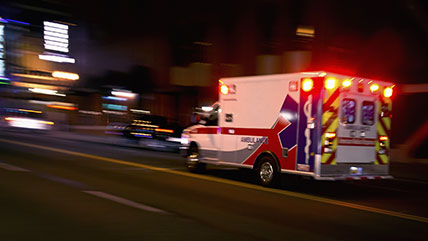Should EMS Reduce the Use of Lights & Sirens? Part I
By Brian Maloney *
When people ask me why I got into emergency medical services I tell them the story of taking a CPR class while in college. I completely fell in love with the idea of being able to help people in their time of need and helping people was the primary reason I got into EMS 24 years ago. I truly still feel that way today. I would also be lying if I did not say it was also about the idea of high adrenaline-type situations and getting the opportunity to drive an emergency vehicle with lights and sirens (L&S). Now that is fun!
The question we must ask ourselves is even though driving with L&S is fun and at times potentially lifesaving, is it the right thing we should be doing as much as we are?

National Highway Traffic Safety Statistics
Are emergency drivers more likely to engage in risky behavior when lights and sirens are flashing? How often do the other drivers on the road freeze, panic, and cause accidents?
According to NHTSA, it is estimated that more than an average of 1,500 ambulance crashes occurs per year accounting for over 2,600 injuries and an average of 33 fatalities annually. The National Safety Council found that the moment we flip the switch to “light em’ up” while responding to a call we increase our chances of getting into a wreck by 50%. What is even worse, we TRIPLE the chances of getting into a crash while transporting a patient to the hospital while using L&S. I am not much of a gambling person, but those do not sound like very good odds.
Is this just the way EMS is, or can something be done to help improve our chance of going home in one piece at the end of the shift and increase the safety of the community?
Pennsylvania Review
Back in 2018, the team of Plum EMS started looking at the use of L&S while transporting patients to the hospital. It started off with a review of the Pennsylvania protocol regarding emergency vehicle use and noticed it set a “performance parameter” benchmark of 1% or less when using L&S during transport. At first, we thought this was a joke and completely ridiculous as in the previous two years we were using L&S during transport to the hospital at a rate of 23.85% and 26.8%. The goal initially appeared near impossible; however, the team of Plum EMS liked a good challenge, so they said what the heck? Let’s do it and the following is how it got started.
- During our morning meetings, we reviewed the protocol along with the 1% benchmark for use of L&S during transport to the hospital. There were also several sections that provided good examples of when it is appropriate to use L&S – impending cardiac arrest, inability to obtain a patent airway, critically unstable patient, when the senior crew member feels will be worsened by a delay equivalent to the time that can be gained by emergent transport, etc.
- Crew members were also required to add a “Special Report” for any patient care record utilizing L&S during transport and elaborate on the reasons why they transported the way they did.
By end of 2018, the Plum EMS team exceeded my expectations and dropped the number of patients transported to the hospital using L&S down to 12.2%. Maybe this wasn’t such a ridiculous adventure after all!
New Year, New Goal
In 2019, the organization continued with its goal to lower the use of L&S during transport to the hospital. An additional step was taken, and feedback was provided to the crew for any patient transported L&S to the hospital. This feedback consisted of a comparison of the actual transport time to an estimated time mapped out on Google Maps©. The time difference between the two was typically 3-5 minutes. Crews were challenged to consider if they felt this truly made a difference or an impact on their patient’s outcomes. As 2019 ended, the team was down to 10.2%!
In 2020 and 2021, we continued to discuss topics during our morning meetings and provided feedback to the crews. The team had decreased to 8.42% by the end of 2021.
Stay tuned for Part II which includes Plum EMS’ involvement in a national project along with 49 other departments nationwide.
*Brian Maloney is the Operations Director for Plum EMS in Plum, PA. He has over 24 years of experience in the EMS Industry.